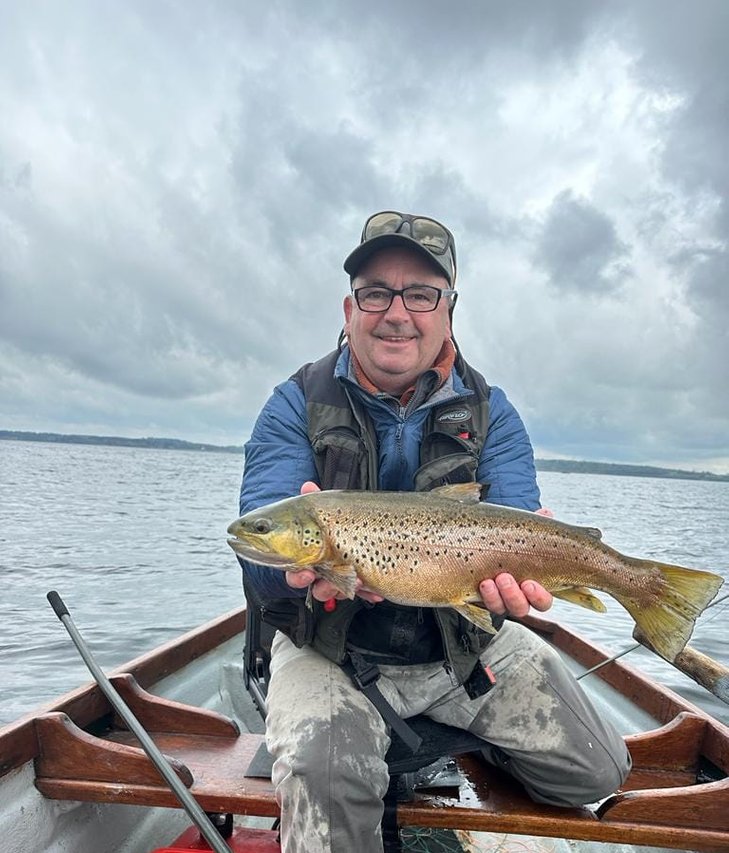LOUGH OWEL BACK END FRY FEEDERS
Lough Owel is situated right in the heart ofthe midlands, a lake renowned for its hard fighting brown trout, both wild andstocked. But unfortunately the wild trout in Lough Owel are not as numerous asthey once were. So you really are targeting the stocked fish,. These introducedtrout are not the tail less diploid stocked browns we have caught over the lastnumber of decades, these trout are triploids.
What’s the difference you may ask, triploidtrout are sterile. However, they’re not true genetically-modified fish.Genetically modified fish have their genetic material changed by inputtingdesired traits from other organisms. Triploids haven’t had their DNA modified.However, they had a third set of chromosomes added to their DNA to make theminfertile, that means everything they eat goes into growth, body weight andmuscle. These trout grow a much better rate than diploid trout and will not /cannot spawn with native wild trout , so they are an ideal fish to stockinto fisheries.
HOW ARE TRIPLOID TROUT CREATED?
The science behind creating triploid troutisn’t overly complicated. The whole goal is to move away from the traditionalXX (female) and XY (male) chromosomes and create XXX (female triploid) and XXY(male triploid) trout. There are two ways that they are most often created:heat shock and pressure treatment.
Scientists will begin by applying the thirdchromosome to the egg and fertilizing it. They’ll wait and give it time toproduce what is called a “polar body” that allows the chromosome to attach andbecome a part of the egg. Once this occurs, scientists will “heat shock” theeggs to force that third chromosome to stay on the egg.
Pressure treatment is similar to heatshocking, but instead of high heat, scientists will put the eggs under highpressure to keep that third chromosome attached.
Then you have to think , if they cannot spawn, why are no rainbows in the lake. Well that’s the question we have all beenasking for years, as there are also triploid rainbow trout available and LoughOwel would make a wonderful mixed trout fishery,. But that’s for another day,lets get to the fishing and tactics
Donal Monahan with a lovely Triploid Brown caught in the Leinster qualifier on Lough Owel this year. The fish was returned to the water.
Fry Feeders, Tactics and Flys
Fishing for fry feeders can be absolutely amazing or can be so frustrating.Its either one or the other. You can fish the margins for cruising fish and itshere you will probably catch the biggest ones. Weed beds, rushes or rocky dropoffs all hold fry and the bigger lone fish seem to prefer these areas.
But I prefer to hunt them visually if you can. Fish jumping 3ft foot in theair or numerous splashes are a give away to feeding fish. But don’t forget thebirds, terns and seagulls will follow the marauding shoals of trout as theyhunt the prey fish, the gulls and terns will pick off any stunned fry the troutmiss.
I will always use a 10ft 7 weight rod in conjunction with a floating lineand 8lb Fluro carbon for the top of the water fishing. If I am lucky enough toget among the fish, playing them hard is a must as it gives them a betterchance of going back to their watery home in good condition. The other reasonis that the top of the water fishing happens in fits and bursts and you need tomake the most of the time you have with the feeding fish, so the quicker theyare released the better chance you have of getting another one.
Most of the top water fishing will happen away from shore and the preyshoals move quickly and the trout follow them, so you need to keep your eyespeeled for any movement and drive straight to them. it really is fast andfurious. Thats on a good day, but you will spend many fruitless hours lookingfor them.
In my own experience the surface activity happens early and late most daysgiving good conditions. I will use a variety of sparkler boobies or minky poppers.I fish two fly’s 10ft apart on a 20ft leader, at time a jerky retrieve workswith long pauses and other times they will take them straight off the top likea dry olive. As I said this is the best of the fry feeding and there will belulls during the day and we can employ other techniques.
Fishing lines from a fast intermediate to di 7 will work when you can findthe shoals of prey fish. Big fly’s like snakes, humungus and large minkies canbe fished singly or as a pair. Its all about experimenting and weatherconditions what you fish when and what retrieves you employ. Sometimes theywant large fly’s other days they want smaller fly’s, someday they want fastretrieves other days they want them twiddled.
On a big windy overcast day, traditional Irish pulling will work withstandard dabblers, its all about going out there and doing it.
Boobies and Popper Minkies featured in this article can be got from Fario Fly
or from Irish Stockists of Fario Flys- Southside Angling and Adaire Springs






